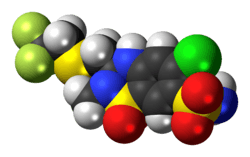Polythiazide
 | |
 | |
| Clinical data | |
|---|---|
| AHFS/Drugs.com | Micromedex Detailed Consumer Information |
| MedlinePlus | a601101 |
| ATC code | C03AA05 (WHO) |
| Identifiers | |
| |
| CAS Number |
346-18-9 |
| PubChem (CID) | 4870 |
| IUPHAR/BPS | 7274 |
| ChemSpider |
4704 |
| UNII |
36780APV5N |
| KEGG |
D00657 |
| ChEMBL |
CHEMBL1587 |
| ECHA InfoCard | 100.005.881 |
| Chemical and physical data | |
| Formula | C11H13ClF3N3O4S3 |
| Molar mass | 439.88 g/mol |
| | |
Polythiazide is a thiazide diuretic.[1][2] A diuretic is any substance that promotes the production of urine.
References
- ↑ O'Brien, E. T.; MacKinnon, J. (1972). "Propranolol and polythiazide in treatment of hypertension". British heart journal. 34 (10): 1042–1044. doi:10.1136/hrt.34.10.1042. PMC 458544
 . PMID 5086971.
. PMID 5086971. - ↑ Monroy, A.; Plata, C.; Hebert, S. C.; Gamba, G. (2000). "Characterization of the thiazide-sensitive Na(+)-Cl(-) cotransporter: A new model for ions and diuretics interaction". American Journal of Physiology. Renal Physiology. 279 (1): F161–F169. PMID 10894798.
This article is issued from Wikipedia - version of the 2/15/2016. The text is available under the Creative Commons Attribution/Share Alike but additional terms may apply for the media files.